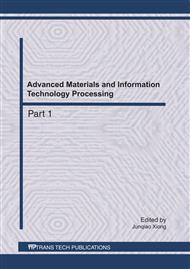[1]
Liu Gui-xiong, Li Xia-ni. Novel decoupling approach to integrated optical-fiber proximity sensor for robot [J]. Journal of South China University of Technology: Natural Science Edition, Vol. 34 (2006), pp.21-25.
Google Scholar
[2]
Yu Dongchuan, Meng Qinghao, Wang Jiang, et al. Neural network based left-inverse system dynamic decoupling & compensating method of multi-dimension sensors[J]. American Control Conference, Vol. 6(2005), pp.1727-1732.
DOI: 10.1109/acc.2005.1470217
Google Scholar
[3]
Jiang Li, Liu Hong, Chai He-hao. Nonlinear static decoupling of multi-axis force/torque sensor[J]Chinese Journal of Scientific Instrument, Vol. 25(2004), pp.284-287.
Google Scholar
[4]
Y. Zhang, J.H. Liu, Y.H. Zhang, X.J. Tang. Cross sensitivity reduction of gas sensors using genetic algorithm neural network[J]. Optical Engineering, Vol. 41(2002), p.615~625.
DOI: 10.1117/1.1448343
Google Scholar
[5]
Xu Kejun , Li Cheng. Dynamic Decoupling and Compensation Met hods of Multi-axis Force Sensors [ J ] . IEEE Transactions on Instrumentation and Measurement, Vol. 49(2000), pp.935-941.
DOI: 10.1109/19.872911
Google Scholar
[6]
Xu Kejun , Li Cheng. The Stationary and Dynamic United Decoupling and Compensating Method in a Multi-axis Force Sensor[J]. Journal of Applied Sciences, Vol. 18(2000), pp.189-191.
Google Scholar
[7]
Song Guo-ming, Zhang Wei-gong, Zhai Yu-jian. Study of dynamic decoupling of sensor based on diagonal predominance compensation[J]. Chinese Journal of Scientific Instrument, Vol. 22(2001), pp.165-167.
Google Scholar
[8]
Liu Gui-xiong, Li Xia-ni, Zhou De-guang. Novel approach of sensing information decoupling based on multiscale computation[J]. Optics and Precision Engineering, Vol. 13(2005), pp.164-167.
Google Scholar
[9]
Ye Ting-dong, Liu Gui-xiong, Huang Guo-jian, Cheng Tie-qun. Novel approach of multi -dimensional sensing information decoupling based on multi-scale approximation[J]. Journal of South China Univer -sity of Technology: Natural Science Edition, Vol. 37(2009).
Google Scholar
[10]
Zhong Cheng-qun, Dong Xi-lu, Zhang Li-yong, Cao Yang. On the Estimation of Variances for Multi-Sensor Measurement[J]. Journal of Data Acquisition & Processing, Vol. 18(2003), pp.412-417.
Google Scholar
[11]
Roal J R, Girja G. Sensor data fusion algorithms using square-root information filtering [J]. IEEE Proc Radar Sonar Naving, Vol. 49(2002), pp.89-96.
DOI: 10.1049/ip-rsn:20020128
Google Scholar
[12]
Sun Shu-li, Deng Zhi-li. Multi-sensor optimal information fusion steady-state Kalman filter weighted by scalars for systems with colored measurement noises[J], Control Theory & Applications, Vol. 21(2004), pp.635-638.
DOI: 10.1115/1.2101844
Google Scholar


